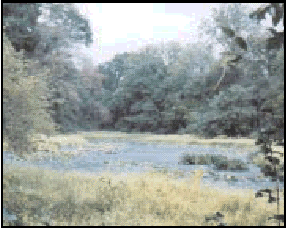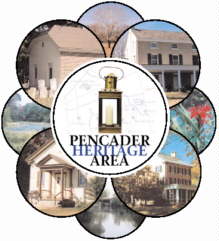 Simply fording the Christina at the foot of Iron Hill proved to be a nearly insurmountable obstacle to the British army in their attempt to seize Philadelphia during the Revolutionary War. After a prolonged sea voyage, during which many men and horses perished, General Howe sailed up the Chesapeake Bay and landed his troops at the Head of Elk. His intent was to avoid the Iron Hill area by approaching from Aikentown (Glasgow) which lay to the south. General Washington had sent General Maxwell to defend the ford with instructions for his volunteers to give the enemy as much trouble as possible. The result was the skirmish at historic Cooch's Bridge, September 3, 1777,a major Pencader landmark and the only site of a Revolutionary confrontation in the state of Delaware, one which left the British floundering in the muck of the Christina's swampland, aptly named Purgatory Swamp. Perhaps the swamp experience left the soldiers in a mood to burn Cooch's mill.
Simply fording the Christina at the foot of Iron Hill proved to be a nearly insurmountable obstacle to the British army in their attempt to seize Philadelphia during the Revolutionary War. After a prolonged sea voyage, during which many men and horses perished, General Howe sailed up the Chesapeake Bay and landed his troops at the Head of Elk. His intent was to avoid the Iron Hill area by approaching from Aikentown (Glasgow) which lay to the south. General Washington had sent General Maxwell to defend the ford with instructions for his volunteers to give the enemy as much trouble as possible. The result was the skirmish at historic Cooch's Bridge, September 3, 1777,a major Pencader landmark and the only site of a Revolutionary confrontation in the state of Delaware, one which left the British floundering in the muck of the Christina's swampland, aptly named Purgatory Swamp. Perhaps the swamp experience left the soldiers in a mood to burn Cooch's mill.
The river also played an important part in the religious practices of the first settlers. Most of Pencader Hundred lies within the area originally known as The Welsh Tract. This tract of 30,000 acres, granted by William Penn on October 15, 1701 to David Evans, William Davis and William Willis, extended from Delaware into Cecil County, Maryland. The area in Delaware included the 340-foot Iron Hill, rich with deposits of ore. The devoutly religious Welsh Baptists were fleeing persecution in their homeland and as many of them were skilled miners and ironworkers, they were drawn to the area where they purchased large tracts of land from the original three proprietors.
Their first priority was to establish meeting houses on the new land. The name Pencader means 'head chair' or 'highest seat' in Welsh, (Pen Cadder) and this is where they built the first log meeting house in 1703. The Old School Primitive Baptists believed in total immersion and Christina Creek, winding its way peacefully through the grove by the church, was the site of many baptisms. The original log church was replaced in 1746 by a hipped roof building of brick, laid in Flemish Bond. Some accounts state that the bricks came from Old New Castle, where a brickyard was established as early as 1659; some say they were ballast from English ships. All seem to agree that they were carried in panniers on mules. The Welsh Tract Primitive Baptist Church remains active and is accepted as the earliest Old School Baptist Church in America. It is one of Pencader's most treasured historic sites.

The cemetery and the church are completely enclosed by a stuccoed stone wall. The gravestone of Rees Rhyddracks, who died at the age of 87, is dated 1707 and is the oldest in the cemetery. The Christina streambed was the source of brownstone used for the earliest tombstones which are inscribed in Welsh. They are crudely incised with simple chiseling tools but are still legible after nearly 300 years. From baptism to burial, the stream provided.
The graveyard is the subject of much local folklore. One tale has black slaves being buried inside the wall, in the far eastern corner, in unmarked graves. Another has black, baptized members interred in a small plot, outside the wall, marked only by rough bluish stones. Yet another version has unknown Revolutionary War soldiers buried, in a line, in unmarked graves inside the wall all along the eastern edge of the cemetery. And to make things even more interesting, the diary of a Hessian soldier states the locals were kept busy burying their unknown dead soldiers outside the wall of the church after the battle of Cooch's Bridge.
Our Delaware poet, Townsend captured the air of mystery surrounding the churchyard: |
